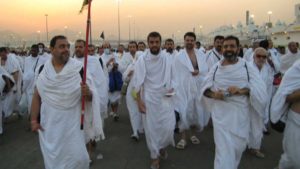BY: SACHIKO MURATA, WILLIAM C. CHITTIC
The hajj is a set of rituals that take place in and around Mecca every year, beginning on the eight and ending on the thirteenth day of the last lunar month, Dhu’l-Hijja (The Month of the Hajj). Mecca was a sacred center long before Islam, and according to Muslim belief, Adam himself built a sanctuary at Mecca. Eventually it was rebuilt by Abraham, and by the time of the appearance of Islam, the Kaaba (cube) had long been a place of pilgrimage for the Arab tribes. The Koran and the Prophet modified and resanctified the rituals performed at the Kaaba, making them a pillar of the religion.
Muslims are required to make the hajj once in their lifetimes, but only if they have the means to do so. To understand some of the significance of the hajj, one needs to remember that steamships, airplanes, and buses are products of the past hundred years. For thirteen hundred years, the vast majority of Muslims made the journey to Mecca on foot, or perhaps mounted on a horse or a camel. It was not a matter of taking a two-week vacation, and then back to the office on Monday morning. Rather, for most Muslims the hajj was a difficult journey of several months if not a year or two. And once the trip was made, who wanted to hurry? People stayed in Mecca or Medina for a few months to recuperate and to prepare for their return, to meet other Muslims from all over the Islamic world, and to study. Often they stayed on for years, and often they simply came there to die, however long that might take.
Today, one can go to Mecca in a few hours from anyplace in the world. Some people decide to do the hajj this year because they did Bermuda last year. In the past, most Muslims had to fulfill strict conditions in order to make the journey. In effect, they had to be prepared for death. They had to assume that they would never return, and make all the necessary preparations for that eventuality. One of the conditions for making the hajj is that people have to pay off all their debts. If a man wanted to make the hajj, but his wife did not want to accompany him, he had to make sure that she was provided for in the way in which she was accustomed. He had to see to the provision of his children as well, and anyone else for whom he was responsible.
Traditionally, the hajj was looked upon as a grand rite of passage, a move from involvement with this world to occupation with God. In order to make hajj, people had to finish with everything that kept them occupied on a day-to-day basis. They had to answer God’s call to come and visit Him. The hajj was always looked upon as a kind of death, because Koran repeatedly describes death as the meeting with God, and the Kaaba is the house of God. The hajj, in short, was a death and a meeting with God, and the return from the hajj was a rebirth. This helps explain why the title “hajji” (“one who has made the hajj”) has always been highly respected throughout the Islamic world. Hajjis were looked upon as people who were no longer involved with the pettiness of everyday life. They were treated as models of piety and sanctity, and no doubt most of them assumed the responsibilities toward society that the title implies, even if some took advantage of the respect that was accorded to them.
Excerpted from the book “The Vision of Islam” by Sachiko Murata and William C. Chittick.
source: islmicity.com



